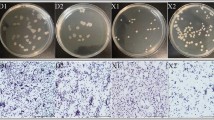Abstract
Among 59 Korean isolated, 20 were confirmed as members of the genusBifidobacterium species based on gram staining, microscopic examination of cell morphology and the TLC method. The oxygen tolerance and antioxidative activities of these 20Bifidobacterium strains and 5 standardBifidobacterium strains were tested. All the strains demonstrated antioxidative activities as regards inhibiting linoleic acid peroxidation. The antioxidative activities of isolated and standard strains were found to range from 10.7–46.4% and from 10.7–22.2%, respectively. In addition, all tested strains exhibited a scavenging ability on DPPH free radicals, range from 15–41% for the isolated strains and 8.3–22% for the standard strain. Accordingly, the isolatedBifidobacterium strains demonstrated higher antioxidative activities than the 5 standardBifidobacterium strains. On the base of grades for each test, HJL 7511 was identified as the best strain, followed by HJL 7501. 2 strains were identified with Polymerase Chain Reaction (PCR) assay using group-specific primers designed from the nucleotide sequences of the 16S rRNA and internal transcribed spacer (ITS) regions of the Bifidobacteria. Based on the sequencing results, HJL 7511 and HJL 7501 were identified asBifidobacterium infantis.
Similar content being viewed by others

References
Benzkorovainy, A. and M. C. Robin (1998)Biochemistry and Physiology of Bifidobacteria. Robin Miller-Catchpole Editor. pp. 73–92. CRC Press, Florida, USA.
Gismongo, M. R., L. Drago and A. Lombardi (1999) Review of probiotics available to modify gastrointestinal flora.Int. J. Antimicro. Agents 12: 287–292.
Gilliland, S. E. (1990) Health and nutritional benefits from lactic acid bacteria.FEMS Microbiol. Rev. 87: 175–188.
Homma, N. (1988) Bifidobacteria as are resistance factor in human beings.Bifidobact. Microfl. 7: 35–43.
Mitsuoka, T. (1990) Bifidobacteria and their role in human health.J. Ind. Microbiol. 6: 263–268.
Hosono, A., R. Wardojo, and H. Otani (1990) Inhibitory effects of lactic acid bacteria from fermented milk on the mutagenecities of volatile nitrosamines.Agr. Biol. Chem. 54: 1639–1643.
Rasic, J. L., I. F. Vujicic, M. Skrinjar, and M. Vulic (1992) Assimilation of cholesterol by some cultures of lactic acid bacteria and bifidobacteria.Biotechnol. Lett. 14: 39–44.
Halliwell, B. (1994) Free radicals and antioxidants: A personal view.Nutr. Rev. 52: 253–265.
Halliwell B. and S. Chirico (1993) Lipid peroxidation: Its mechanism, measurement, and significance.Am. J. Clin. Nutr. 57: 715S-725S.
Halliwell, B. and J. M. C. Gutterudge (1984) Oxygen toxicity, oxygen radicals, transition metals and disease.J. Biochem. 219: 1–4.
Jensen, M. A., J. A. Webster, and N. Straus (1993) Rapid identification of Bacteria on the basis of polymerase chain reaction-amplified ribosomal DNA spacer polymorphism.Appl. Environ. Microbiol. 59: 945–952.
Laguerre, G., M. R. Allard, F. Revoy, and N. Amarger (1994) Rapid identification of Rhizobia by restriction fragment length polymorphism analysis of PCR-amplified 16S rRNA genes.Appl. Environ. Microbiol. 60: 56–63.
Sykes, G. and F. A. Skinner (1973) Actinomycetales: Characteristics and practical technique for the isolation and characterization ofActinomyces andBifidobacteriuim species.Report of a panel discussion, In Soc. Appl. Bact. Symp. Series No. 2, pp. 327–333. Academic Press, London, UK.
Buch, M. L. and W. L. Porter (1952) Identification of organic acids on paper chromatograms.Anal. Chem. 24: 489–491.
Lee, K. Y. and T. R. Heo (1998) Identification ofBifidobacterium strains at the genus level by thin layer chromatographic determination of organic acids with culture broth of isolated bacteria strain from human feces.Food Sci. Biotechnol. 7: 95–99.
Lin, M. Y. and F. J. Chang (2000) Antioxidative effect of intestinal bacteriaBifidobacerium longum ATCC 15708 andLactobacillus acidophilus ATCC 4356.Digestive Disease Sci. 45: 1617–1622.
Shimada K., K. Fujikawa, K. Yahara, and T. Nakamura (19912) Antioxidative properties of xanthan on the autoxidation of soybean oil in cyclodextrin emulsion.J. Agric. Food Chem. 40: 945–948.
Author information
Authors and Affiliations
Corresponding author
Rights and permissions
About this article
Cite this article
Kim, J.Y., Choi, S.I. & Heo, T.R. Screening of antioxidative activity ofBifidobacterium species isolated from Korean infant feces and their identification. Biotechnol. Bioprocess Eng. 8, 199–204 (2003). https://doi.org/10.1007/BF02935897
Received:
Accepted:
Issue Date:
DOI: https://doi.org/10.1007/BF02935897



